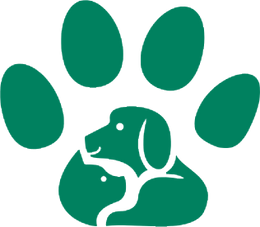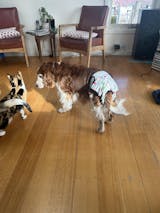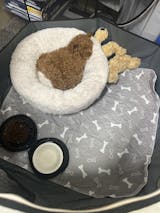Obesity in Dogs - A Major Threat that Goes Unnoticed
Obesity in dogs is recognized as the most significant symptom of malnutrition. The Australian Veterinary Association (AVA) report, 2020, revealed that 41% of dogs and 32% of cats in Australia are either overweight or obese. It also indicates that these animals are in danger of developing health problems due to both treatable and preventive illnesses.

Obesity in pets is a severe problem since it reduces the pet's quality of life, reduces the owner's enjoyment, and predisposes the dog or cat to various potentially fatal ailments. Obesity in pets is caused by the pet consuming more energy than it requires, and in many situations, overweight pets receive little exercise. Simply put, there are too many calories consumed and not enough calories expended during the day.
This blog will provide you with a profound idea about obesity in dogs and how to treat them. Please read it to the end.
What is Animal Obesity?
Animal obesity is described as the accumulation of excess body fat. Most overweight dogs will also have extra body fat because increased body weight and fat prefer to go together.
When determining if a dog is overweight or obese, bodyweight is more straightforward to examine than body fat. Dogs are deemed heavy when they weigh 10-20% more than their ideal body weight according to body weight. Obese dogs are those who have 20 percent or more over their optimal body weight.

Overfeeding mixed with insufficient exercise is by far the most significant factor. When an animal's food consumption (measured in kilojoules (kJ) or calories) surpasses its energy expenditure, the rest is accumulated as body fat. This means that reducing abnormal body weight and obesity in pets is primarily dependent on portion control and increased exercise or activity throughout the day.
Obesity can affect dogs of any age, but it is most common in dogs in their middle years, between the ages of 5 and 10. Dogs who are neutered and kept indoors are also more likely to become obese.
Risks of Pet Obesity
Pet obesity reduces a dog's life and increases their risk of sickness. Heavy dogs were always thought to have a shorter lifespan than slender dogs, usually by 6-12 months. However, an extensive, long survey of Labrador Retrievers indicated that being moderately overweight can cut a dog's life expectancy by approximately two years compared to thinner dogs. This is a startling figure.
Previously, fat was thought to be a relatively inert tissue that only stored surplus energy calories and increased body mass. However, new research indicates that fat tissue is metabolically active. It secretes inflammatory hormones and puts the body's tissue under oxidative stress, both of which lead to various disorders.

Obese dogs are more likely to develop:
- Cancers, diabetes, heart disease, and hypertension, to name a few.
- Osteoarthritis and a quicker deterioration of the afflicted joints are also possible outcomes.
- Stones in the urinary bladder
- They are less heat tolerant, which can lead to anesthetic problems.
Obesity, on the other hand, may be a symptom of a condition, such as hypothyroidism (an underactive thyroid gland) or Cushing's disease (overactive adrenal glands).
How to Find Obesity in Dogs?
It's essential to get professional guidance if you're not sure whether or not your dog is overweight. Ideally, your veterinarian will assist you in making this decision. However, you can search for some signs of obesity in dogs at home in-between visits.
Check The Body Shape
If you observe that your dog appears chubby and oval-shaped when viewed from above, your dog is likely overweight. On the other hand, if your dog has a definite waist at the back and a straight build down the sides, they're generally at a healthy weight.
Feel For Your Dog's Ribs
If your dog's ribs aren't too noticeable and you can feel them without pressing too hard, he's in good shape. However, because there is so much fat in the way, it's difficult for overweight dogs to feel their ribs.
Look From The Side
Another indicator of an obese dog is a sagging waist or swinging tummy. When looking at your dog from the side, look for a slightly elevated waist rather than one that is just hanging down and oval-shaped.

Check For Fat Pads
Excess fat on your dog's body is another sign that they are overweight. Some animals have fat pouches between their legs that cause them to shuffle when walking. During petting sessions, check your dog's hips. Fat pads will develop on the tops of overweight dogs' hips.
Examine Their Behavior
Overweight and obese dogs are often idle and invest a lot of time eating. If you find that your dog has become a couch potato, has difficulty walking, has problems breathing when walking, and looks to have trouble moving about in general, they may be overweight.
How to Lose Obesity in Dogs?
Ensuring your dog is in good form is a vital part of being a competent dog parent. You may think your chubby dog is lovely just the way he is, but it can be obesity in dog. In addition, even the tiniest weight increase will have a more significant impact on certain breeds than others, so it's critical to keep your dog fit throughout his life.
Proper Diet
Dogs acquire weight the same way humans do: they overeat and don't exercise enough. Excessive snacks, table scraps, and food at mealtimes will cause dogs to gain weight quickly, especially if they are not active. Have your veterinarian authorize any new diet or exercise regimen for your dog before you begin? Measuring foods can be helpful. You can use an electric pet food scale by Dry Paws.

Feeding your dog his regular food in the morning but changing his second meal with primarily green beans (low sodium), a little kibble, and a doggie multivitamin in the evening is a simple way to jump-start your dog's weight loss. Changing your dog's treats to healthier ones will also assist him in losing weight. You can also add these food in a snuffle mats. Snuffle mats are a great way to keep your pup busy while feeding. Click to buy quality snuffle mats from drypaws.
Appropriate Exercise is The Key!
Of course, more exercise will aid in animal obesity. Most dogs enjoy going for a walk, a run, a swim, or a hike, so take him outside and participate in some outside activities with him! It's recommended to start slow with an obese dog and gradually increase activity as he loses weight. However, be careful not to overwork him, especially if he has a medical issue, and keep an eye out for signs of heatstroke. Always keep water and collapsible dog bowl to give him some water.

Train Them to Run
You shouldn't run with your obese dog. Wait until they lose some weight or start as slow as possible. If you decide to go for a run with your dog, keep in mind his age. Running on hard surfaces like concrete or asphalt repeatedly can cause joint injury in children. Many breeders, giant breeds, advise against running on hard surfaces until a dog is 12 months old, preferably 18. Instead, go outside and play on grass or another soft surface like packed sand. Always use a dog training leash to hold your dog. Or else they can run anytime😅😅😅

Check with your veterinarian to ensure he doesn't have any physical conditions that could make running difficult or even hazardous, like heart problems, orthopedic issues like hip dysplasia, or a luxating patella.
Make Exercise Fun
Canine sports are a terrific way to exercise your dog while strengthening your friendship. However, agility, which is essentially a timed obstacle course, necessitates the use of hand signals and body language to communicate with your dog, and all that zipping through tunnels and jumping over jumps burns a lot of calories.
Keep an eye on your dog's appearance and behavior at all times. If he's panting heavily, slow down or halt and find an excellent or shaded location for some respite. Dogs of all breeds are susceptible to overheating. So use a dog cooling mat.

Control Diet for Obese Dogs
There are a few tried-and-true strategies for slimming down, just as for humans. To begin, consult your veterinarian to ensure that the extra weight is not the result of an underlying health issue or disease. Also, before changing your dog's food or reducing calories, get your dog examined and consult with your veterinarian about the best options. Check out these helpful hints after you've completed these steps:
Measure Meals: One of the most critical aspects of any human weight-loss regimen is keeping a diary. You'll have to do it for him because dogs can't write. Using a measuring cup, keep track of how much kibble you're feeding. You can use the electronic pet food scale by Dry Paws. You will be able to measure dry or wet food with this scale. And it is easy to wash!
Establish a Schedule: Offer meals on a defined timetable if you free-feed and leave food out all day. Place the food down for a set period, such as 15 minutes, and pick up any food the dog does not consume.
Limit Between-Meal Snacks: Dogs consume many calories in contrast to their regular chow. Anything from training incentives to a cookie slipped over the fence by a friendly neighbor can be used. Those calories build up over time. Determine the source of the extra treats and track how many the dog receives.
Choose Low-Calorie Treats: Many store-bought snacks, mainly biscuits, are high in fat. Unfortunately, chews are the same way. However, fruits and vegetables, such as bananas, carrots, green beans, and apple slices, will make some dogs just as pleased.

Various chews, such as the well-known bully sticks, contain more calories than most people realize. A recent study from Tufts University's Cummings School of Veterinary Medicine looked at the nutrients found in 26 different types of bully sticks. Between 9 and 26 calories were present in each inch. "While calorie information isn't required on most pet treats or foods, these findings reinforce the need for veterinarians and pet owners to be aware of pet treats like these bully sticks as a source of calories in a dog's diet," Lisa M. Freeman, DVM, PhD, DACVN, professor of nutrition at TCSVM, said in a news release announcing the study findings. As a result, several firms have created commercial low-calorie treats.
What to Eat for an Obese Dog?
Regarding food quality, Osborne suggests eating fresh foods like chicken, turkey, fish, eggs, and tofu and fiber-rich vegetables like Brussels sprouts, broccoli, cauliflower, kale, cabbage, and spinach.
While some dog owners are hesitant to eat "human food," this type of actual, fresh food is higher in nutrient density and bioavailability than dried, processed food. Those who plan to cook fresh food at home for an extended period should visit their veterinarian to verify that meals are properly balanced and contain the necessary vitamins and nutrients. It's easier and safer to offer nutritionally balanced meals when you subscribe to a fresh-food plan.

What to Do After Reaching the Losing Weight Goal?
Since we're at the last part of our writings, we still have a question. What to do when the dog has reached the goal? You obviously don't want to go back to the food that triggered the issue in the first place. So instead, I strongly advise sticking to the Diet while making minor tweaks, as detailed below.
Minced beef, lamb, and chicken skin, all of which contain more significant levels of fat, will have been off the menu while you were transforming your dog into a new, leaner, and happier hound. You can gradually add a more comprehensive selection of components once your dog has attained their goal weight.
Your dog's weight has been dropping because you've been providing them somewhat less food than they need. You can now begin to feed slightly more. After a while, you'll notice that you can alter the portion size purely by feeling rather than using the scales.
A maintenance diet for a dog over 10kg should consist of about 2% of their body weight in food (including edible bones) every day. Try the following for dogs under 11kg:
- 1–2kg: 10% of body weight
- 3–4kg: 7% of body weight
- 5–8kg: 5% of body weight
- 9–10kg: 3% of body weight
- 11kg+: 2% of body weight

















